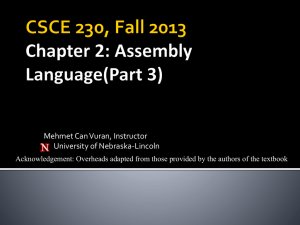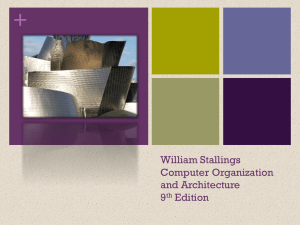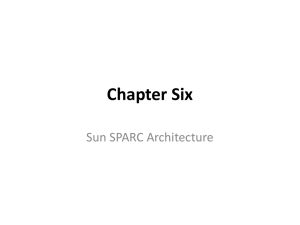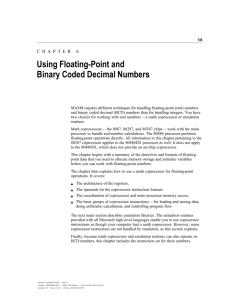SPARC Processor
advertisement
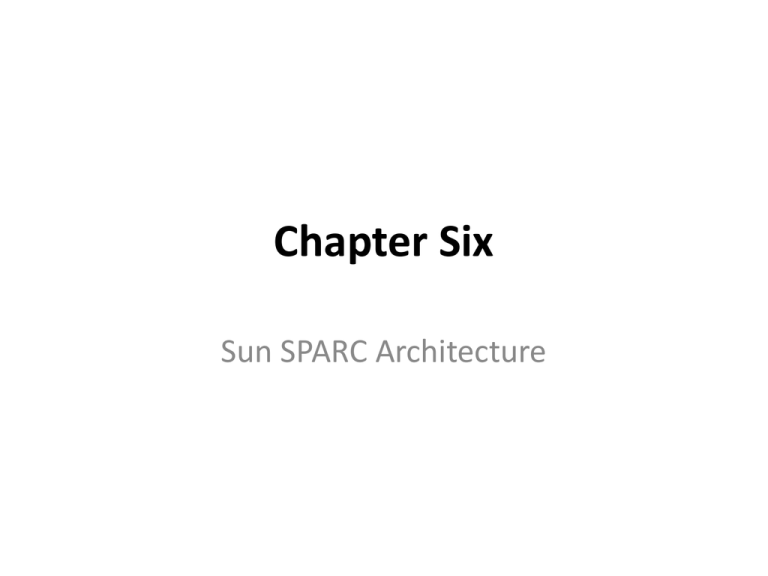
Chapter Six Sun SPARC Architecture SPARC Processor • The name SPARC stands for Scalable Processor Architecture • SPARC architecture follows the RISC design philosophy by stressing importance of – Large CPU register file – Similar register window features RISC Vs CISC • The historical background: – In first 25 years (1945-70) performance came from both technology and design. – Design considerations: o small and slow memories: compact programs are fast. o small no. of registers: memory operands are used instead o attempts to bridge the semantic gap: model high level language features in instructions. o no need for portability: same vendor application, OS and hardware. o backward compatibility: every new ISA must carry the good and bad of all past ones. • Result: powerful and complex instructions that are rarely used. • Such type of processors were classified as CISC. CISC • CISC is an acronym for Complex Instruction Set Computer. • These chips are easy to program and make efficient use of memory. • CISC philosophy made sense as the earliest machines were programmed in assembly language and memory was slow and expensive • Most common microprocessor designs such as Intel 80x86 and Motorola 68K series followed the CISC philosophy. RISC Vs CISC • Later it was found as follows: What is RISC? • Reduced Instruction Set Computer(RISC) is a type of microprocessor architecture that utilizes a small, highly-optimized set of instructions than a more specialized set of instructions often found in other types of architectures • The characteristic of most RISC processors are: – one cycle execution time: RISC processors have a CPI (clock per instruction) of one cycle. This is for the optimization of CPU pipelining – large number of registers: RISC design generally incorporates a larger number of registers to reduce the number of interactions with memory CISC RISC • Extensive instructions. • Reduced instruction set. • Complex and efficient • Less complex, simple machine instructions. instructions. • Hardwired control unit and • Microencoding of the machine instructions. machine instructions. • Few addressing schemes • Extensive addressing capabilities for memory for memory operands with operations. two basic instructions LOAD and STORE • Many symmetric registers • Relatively few registers. which are organised into a register file. SPARC Processor • SPARC Processor was introduced by Sun Microsystems in 1987 as an architectural family. • It is an open architecture : semiconductor vendors can produce SPARC chips using various implementation domains: CMOS,ECL and GaAs SPARC Features • A linear 32-bit address space • Few and simple instruction formats — All instructions are 32 bits wide. – Only 3 basic instruction formats – Uniform placement of opcode and register address fields in instruction – Only LOAD and STORE instructions access memory and I/O. • Few addressing modes — An address may be “register + register” or “register+immediate.” SPARC Features • Triadic register addresses— Most instructions operate on two register operands (or one register and a constant) and place the result in a third register. • A large “windowed” register file — At any one instant, a program sees 8 global integer registers plus a 24-register window into a larger register file. • A separate floating-point register file SPARC Features • Delayed control transfer— The processor always fetches the next instruction after a delayed control-transfer instruction. • Fast trap handler • Tagged instructions • Multiprocessor synchronization instructions • Coprocessor— The architecture defines a straightforward coprocessor instruction set, in addition to the floating-point instruction set. SPARC Architecture • SPARC is an instruction set architecture (ISA) with 32-bit integer and 32-, 64-,and 128-bit floating point as its principal data types. • SPARC processor logically comprises 3 units: – an Integer Unit (IU) – a Floating-Point Unit (FPU) – an optional Coprocessor (CP), each with its own registers. (32-bits wide). SPARC Processor • SPARC processor can be in either of 2 modes: – Supervisor mode: The processor can execute any instruction including the privileged instructions. – User mode: “User Application” programs will be executed in user mode. An attempt to execute a privileged instruction will cause a trap to supervisor software. THE MODULES Floating-Point Unit (FPU) CoProcessor (CP) Integer Unit (IU) THE MODULES Floating-Point Unit (FPU) CoProcessor (CP) Integer Unit (IU) INTEGER UNIT (IU) • Contains the general purpose registers and controls the overall operation of the processor. • Executes the integer arithmetic instructions and computes memory addresses for loads and stores. • Maintains the program counters and controls instruction execution for the FPU and the CP. • May contain from 40 to 520 general-purpose 32-bit registers • It corresponds to – 8 global registers and – a circular stack of from 2 to 32 sets of 16 registers known as register windows. – Thus (2*16=32+8=40) to (32*16+8 =520) Integer Unit (IU) REGISTER WINDOW CONCEPT • Each instruction can access the 8-globals and a register window • A 24- register window comprises – 8 in – 8 local registers – 8 out registers( which are together with the 8 in registers of an adjacent register set, addressable from the current window) Integer Unit (IU) THE MODULES Floating-Point Unit (FPU) CoProcessor (CP) Integer Unit (IU) FLOATING-POINT UNIT (FPU) • The FPU has thirty-two 32-bit-wide registers. – Double-precision values occupy an even-odd pair of registers – Quad-precision values occupy a quad aligned group of four registers. • Floating point load/store instructions are used to move data between the FPU and memory. • The memory address is calculated by IU • FPop(Floating Point Operate) instructions perform the actual Floating Point Arithmetic THE MODULES Floating-Point Unit (FPU) CoProcessor (CP) Integer Unit (IU) Coprocessor Unit • The instruction set includes support for a single, implementation-dependent coprocessor. • The coprocessor has its own set of 32-bit registers. • Coprocessor load/store instructions are used to move data between the coprocessor registers and memory. Data Formats SPARC Data Formats • The SPARC architecture recognizes three fundamental data formats (or types): – Signed Integer— 8, 16, 32, and 64 bits – Unsigned Integer— 8, 16, 32, and 64 bits – Floating-Point — 32, 64, and 128 bits • The format widths are defined as – Byte — 8 bits – Halfword— 16 bits – Word/Singleword — 32 bits SPARC Data Formats – Tagged Word— 32 bits (30-bit value plus 2 tag bits) – Doubleword— 64 bits – Quadword— 128 bits Signed Integer • Signed Integer formats encode two’scomplement whole numbers Signed Integer Unsigned Integer • Unsigned Integer formats are general-purpose and hence they do not encode any particular data type. • They can represent a whole number, string, fraction, boolean value, etc. Unsigned Integer Unsigned Integer Floating Point Numbers Floating Point Numbers





